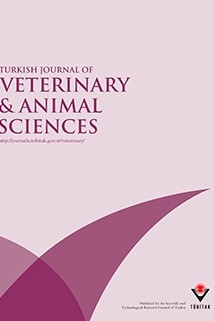
Turkish Journal of Veterinary and Animal Sciences
Yazarlar: Altan AKSOY, Murat YILDIRIM, Birgül KAÇMAZ, Teoman Zafer APAN
Konular:-
Anahtar Kelimeler:Cattle,Sheep,Escherichia coli,Verotoxin,Antibiotic resistance
Özet: In this study, 130 Escherichia coli strains isolated from 306 cattle and sheep fecal samples were studied for their resistance to 10 antibiotics, verotoxin production, and hemolyzation. The antibiotic resistance rates of the E. coli strains were as follows: tetracycline, 51.6%; streptomycin, 24.2%; ampicillin, 13.1%; amoxicillin/clavulanic acid, 5.2%; gentamycin, 4.6%; ciprofloxacin, 4.6%; trimethoprim-sulfamethoxazole, 4.3%; cefotaxime, 0.7%. None of the strains were resistant to cefepime or ceftazidime. Of all the antibiotics tested, only resistance to streptomycin was higher in the strains isolated from cattle than in the sheep strains (P = 0.043). The evaluation of the cattle strains, based on gender and age, indicated that the resistance to tetracycline and streptomycin was higher in the female cattle than in male cattle, whereas in cattle under 2 years of age resistance to tetracycline was significantly higher than in 3-year-old cattle. Among the cattle strains there were 4 (2.2%) of the VTEC 0157 serotype. All were sensitive to the antibiotics tested, and the isolation rate of VTEC non-0157 serotypes was 14.5%. The overall verotoxin production rate of the E. coli strains was 36.9%, while it was 61.1% in sheep strains and 19.7% in cattle strains. Verotoxin production in sheep strains was significantly higher than in cattle strains (P < 0.001). No correlation was detected between verotoxin production in the cattle strains and antibiotic resistance; however, resistance to ampicillin and streptomycin in the sheep strains that did not produce verotoxin was higher than that observed in the sheep strains that did (P = 0.048 and P = 0.009, respectively). The most common hemolysis type in the isolated E. coli strains was gamma hemolysis (46.2%). Ampicillin and amoxicillin/clavulanic acid resistance was significantly higher in the strains that hemolyzed than in the strains that did not. In conclusion, sheep carry higher risks of verotoxin produced by E. coli strains than cattle do. Furthermore, due to higher resistance rates to such antibiotics as tetracycline and streptomycin, careful antibiotic selection for infections, particularly those caused by verotoxigenic E. coli, is of extreme importance.